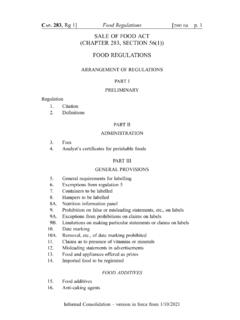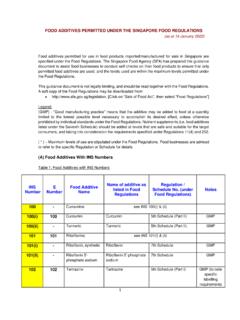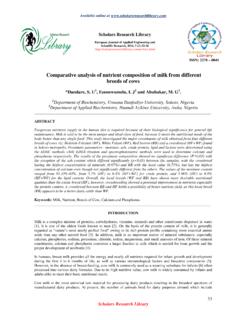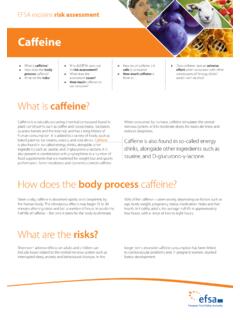Transcription of A Guide to Food Labelling and Advertisements
1 0 A Guide to Food Labelling and Advertisements A publication of the Singapore Food Agency (SFA) First published Feb 2010. Amendments Oct 2011, Oct 2013, Jul 2014, Jan 2015, Jul 2015, Mar 2016, Aug 2018, Feb 2019, Apr 2019 1 Content Page Introduction .. 2 General Labelling Requirements .. 4 Additional Labelling Requirements .. 12 Date-marking of expiry date .. 12 Foods containing sweetening agents .. 14 Special purpose foods .. 15 Nutrition Labelling .. 17 Specific Labelling requirements for certain food categories .. 19 Advisory statements .. 20 Prohibited Claims on Food Labels and Advertisements .. 21 Use of Nutrition Claims and Health Claims .. 22 Nutrition claims .. 22 Health claims .. 25 (i) Nutrient function claims and other function claims.
2 25 Application for new health claims .. 48 Methods of Analysis .. 49 Contacts .. 50 Appendix I: Types of health claims as defined under the Codex Guidelines for Use of Nutrition and Health Claims .. 51 Appendix II: Checklist for food labels and Advertisements .. 53 2 Introduction This Guidebook aims to provide food importers, distributors, manufacturers, producers, packers and retailers (hereinafter known as industry members ) with a better understanding of the Labelling requirements of the Food Regulations, as well as the permitted and prohibited claims for use in food labels and Advertisements . This Guidebook includes a self-checklist to assist industry members to self-check your food labels and Advertisements before sale/publication.
3 Industry members are responsible to ensure that your food products comply with the safety, specification standards and the Labelling requirements stipulated under the Food Regulations. In addition, industry members are advised to make reference to the Sale of Food Act and the Food Regulations for the actual legal text where necessary. The legislation can be downloaded from the following websites: Please note that the information and the checklist provided in the material do not serve as any forms of certification or approval of food labels. 3 We would like to remind industry members that it is an offence to sell prepacked foods without proper Labelling or to make false or misleading claims for food products.
4 The penalties for non-compliance are stated under Section 49 of the Sale of Food Act and regulation 261 of the Food Regulations; relevant sections are quoted below: Section 49 of the Sale of Food Act Any person who is guilty of an offence under this Act for which no penalty is expressly provided shall be liable on conviction to a fine not exceeding $5,000 and, in the case of a second or subsequent conviction, to a fine not exceeding $10,000 or to imprisonment for a term not exceeding 3 months or to both. Regulation 261 of the Food Regulations Any person who contravenes or fails to comply with any of the provisions of these Regulations shall be guilty of an offence and shall be liable on conviction to a fine not exceeding $1,000 and in the case of a second or subsequent conviction to a fine not exceeding $2,000.
5 4 General Labelling Requirements The following basic information is required to be declared in English on the labels of prepacked foods: (a) Name or description of food A common name or a description which is sufficient to indicate the true nature of the food product. Refer to Part IV Standards and Particular Labelling Requirements for Food of the Food Regulations to ensure that the terms used for the common name or the descriptions comply with the requirement. (b) Statement of ingredients A complete list of ingredients and additives used in the food listed in descending order of the proportions by weight in which they are present. For instance, the ingredients listed at the top of the list should be the one that weighed the most compared to the rest of the ingredients.
6 The exact identity or the permitted generic terms1 of the ingredients and additives should be declared. International Numbering System (INS) number or E number can be used for declaration of food additives. It is not mandatory to state that a food contains water. For compound ingredients which comprise more than one constituent , the constituents should be declared in descending order. For example, soy sauce (water, soybean, black bean, salt, sugar) . 1 Under regulation 5(4)(b) of the Food Regulations, the name and description of ingredients should indicate their true nature. Only generic terms listed in the First Schedule of the Food Regulations can be used for the respective food groups.
7 However, do note that: (i) the use of the synthetic colouring matter, tartrazine must be disclosed under the statement of ingredients as either "tartrazine", or "colour (102)" or "colour (FD&C Yellow #5)" or similar words; (ii) the source of ingredients and additives from allergenic sources should be disclosed [see part (c) below] 5 (c) Declaration of foods and ingredients known to cause hypersensitivity Regulation 5(4)(ea) requires declaration of foods and ingredients known to cause hypersensitivity. The following foods and ingredients are required to be declared when present as an ingredient/additive or as a component of a compound ingredient: (i) Cereals containing gluten This group includes wheat, rye, barley, oats, spelt or their hybridised strains and their products.
8 (ii) Crustacean and crustacean products This group includes crayfish, prawns, shrimps, lobsters, crabs and their products. (iii) Eggs and egg products This group includes eggs from laying hens as well as eggs from duck, turkey, quail, goose, gull, guinea fowl and their products. (iv) Fish and fish products This group also includes molluscs such as oysters, clams, scallops and their products. (v) Peanuts, soybeans and their products Peanuts may be declared using similar terms such as groundnuts . Terms such as soya or soy can be used for soybeans. (vi) Milk and milk products (including lactose) This group includes milk from cows, buffaloes, or goats and their products. (vii) Tree nuts and nut products This group includes almond, hazelnut, walnut, cashew nut, pecan nut, Brazil nut, pistachio nut, macadamia nut and their products.
9 (viii) Sulphites in concentrates of 10mg/kg or more Food products that have sulphur dioxide and/or sulphites directly added and/or carried over from food ingredients at a total concentration of 10mg/kg or more (calculated in terms of total sulphur dioxide). 6 Guidance on how to declare Option 1: Declaration using statement of ingredients All food ingredients and additives used in food products, including those listed as food ingredients and additives causing hypersensitivity should be declared clearly in the statements of ingredients in descending order by weight. For compound ingredients comprising two or more food ingredients, the compositions in descending order by weight, should be declared in parenthesis next to the compound ingredients.
10 For example, Batter (water, cornstarch, wheat flour, salt, sodium bicarbonate) Option 2: Declaration using Contains statement When a Contains statement is used, it should appear immediately after the statement of ingredients. However, information provided in the Contains statement should not contradict that declared in the statement of ingredients. All food ingredients and additives used in foods should be declared clearly in the statement of ingredients. The Contains statement should not be used to declare additional food ingredients/additives which are not declared in the statement of ingredients. Allergenic ingredients which are unintentionally introduced into foods such as through contamination or carried-over from such ingredients during manufacturing, transportation, storage or any other means must not be declared in the Contains statement.















